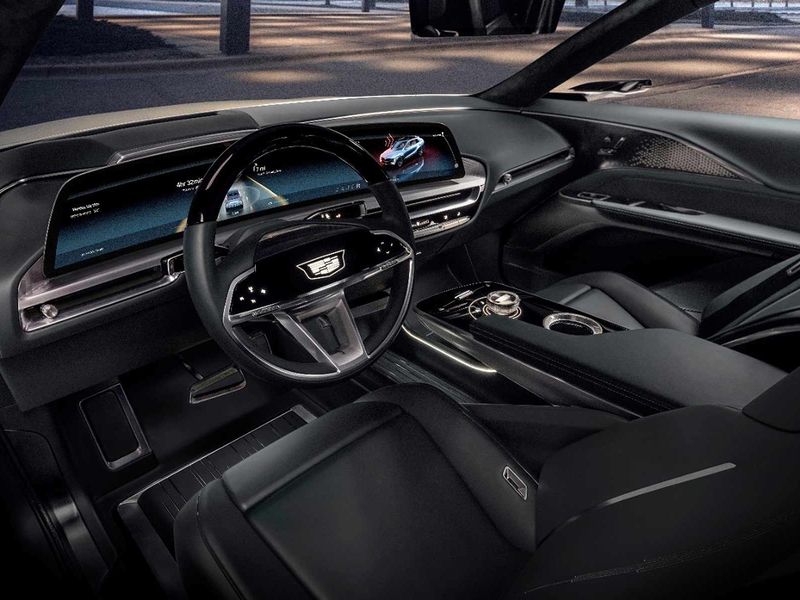
Cadillac may have found its next big thing: screens.
We’ve seen two future Cadillacs — the 2021 Escalade coming this year and the electric Lyriq due in late 2022 — that show the brand aiming for leadership in the race to own screen size.
Both vehicles have massive screens by today’s standards, 38 inches for the OLED screen in the Escalade and 33 inches for the LED screen in the Lyriq. The screens in both vehicles are not the usual tablet style that look a bit like a tombstone protruding from the center of the dash.
Instead, they are neat, thin horizontal devices that stretch from the left of the steering wheel out to the center of the instrument panel or beyond. The screens in both vehicles are smoothly integrated and look like a natural part of the dash, not an add-on.
Cadillac has a history of going big: the 472-cubic-inch V-16 engine made from 1930 to 1940, the massive tail fins on the classic 1959 Eldorado and the 500-cubic-inch V-8 — the biggest regular production engine ever from a Detroit automaker — of the early ’70s are just a few examples.
These features helped build Cadillac’s reputation as America’s premier manufacturer of luxury cars. Aside from some big disappointments, it’s been a while since Cadillac and “biggest” were synonymous.
In recent years, other luxury brands have made vehicles with more power or more opulent interiors. But Cadillac is making a statement with screens in terms of size and high definition. When you add up the square inches of the seat-back screens in the Escalade (25.2 inches) and Lyriq (28.2 inches), and combine that with the size of the screens on the dash, those vehicles probably have more square inches of video screens than most homes.
And while some buyers are increasingly intrigued by the new generation of electronics, it’s not the size of the screen that will be most important, said Sam Abuelsamid, principal analyst leading e-mobility research at Guidehouse Insights. It’s how Cadillac uses it.
The way Cadillac presents information and how effective the screens are in preventing glare, he said, are likely to make or break the deal for many buyers.
“The big screen is fine, but designing the user interface is even more important. Presenting the right information at the right time without being cluttered, and also the display technology itself, has to be really good. You don’t want glare,” said Abuelsamid. “If you are going to rely on these displays to provide all this information, the last thing you want is when the sun is shining in, that the screen information is invisible. The problem with touch screens today is that, depending on where the sun is, the information can just disappear.”
Abuelsamid said screen size, especially in premium brands, is increasing and Cadillac is, if not leading the charge, at least among the leaders.
“We have seen screens growing from a lot of brands, especially premium brands. Tesla really kicked that off with the 17-inch screens in the Model S and Model X. What we see today in many cases is multiple 10- and 12-inch screens. And then as the next generation of vehicles come out, we will see those being consolidated to a single display, which is what you see in the Lyriq.”
Two upstart EV manufacturers, Byton and Lucid, Abuelsamid said, also have shown vehicles with huge screens.
One area where Cadillac is the undisputed leader is with OLED screens. The new Escalade will be the only vehicle on the market with an OLED, or organic light-emitting diode, screen. Although they’re more expensive to produce, OLED screens offer a sharper picture with less distortion than traditional screens.
In the two Cadillacs we’ve seen with the long screens stretching out in front of the driver, you can envision the future of the instrument panel. As the gasoline engine fades away and more room opens up under the hood, the dash can become smaller as the HVAC system moves from behind the dash into the engine bay.
And as self-driving features proliferate, the need to present new and different information to the driver will require bigger and very clear screens. The screens in the Escalade and Lyriq may be a preview of what we’ll see in all vehicles in the coming decades.